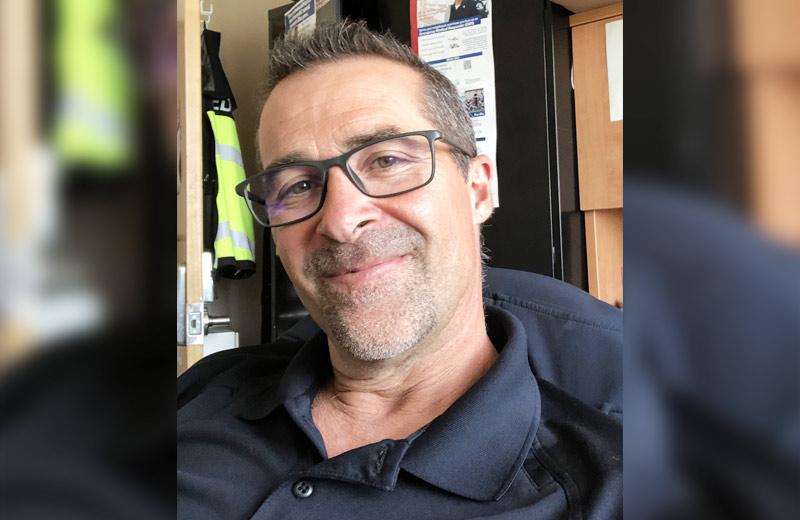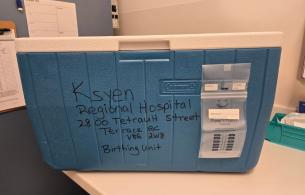“It’s a team thing,” says Tony LaRocque. “I know that’s the secret to making anything work on a community level – just collaborating. Know the resources in the community and work together.”
Tony has been working as a community paramedic in Fort Nelson for about two years. He works closely with the Northern Health care team and collaborates with all the stakeholders in the community to develop programs and provide patient care.
Community paramedicine
Community paramedicine is an innovative approach to the delivery of health care services that allows qualified paramedics to provide primary care services in patients’ homes or in the community. Community paramedics are BC Emergency Health Service employees who work closely with health authorities, ambulance paramedics, the Ministry of Health, and First Nations Health Authority to deliver patient care.
Tony has several programs in Fort Nelson that he has worked to develop with various community organizations and other stakeholders. One of these programs is Home Health Monitoring.
Home Health Monitoring
About 27 people in Fort Nelson and the surrounding communities are part of the Home Health Monitoring program. This program sets up patients with tablets in their homes where they monitor and record their vitals on a daily basis. Patients record information about their blood pressure, blood sugar levels, body weight, and oxygen saturation, which only takes seven minutes to complete.
Home health monitoring allows Tony to catch changes needed to patients’ medications and sets parameters for where vitals should be for a specific person. Tony will follow up with a nurse to review any patients he’s concerned about, and the nurse or Tony will go with the patient to their family doctor’s appointment. Tony or the patient’s family doctor will address anything outside of those parameters. The program encourages patients to advocate for their own health and gives them the information they need to do so.
Tony says about the program, “We regularly get some high-fives going and catch a lot of concerns.”
Living in a rural area like Fort Nelson comes with a set of unique challenges. Some of the communities near Fort Nelson, such as Prophet River and Toad River have up to 200-kilometer drives to see their family doctor, and tough winter conditions can make that difficult. The Home Health Monitoring program adds a lot of value for these patients. They have more information to show their doctor when they do come to Fort Nelson, and they’re more active in advocating for their own health.
Before this program launched, patients wouldn’t have had this information about their vitals, or would have had to visit their family doctor more often.
Wellness clinics
Staying healthy and getting check ups, even when you don’t feel sick, is important. Tony has collaborated with the community to establish five wellness clinics in the Fort Nelson area. The clinic gathers basic health information, such as blood pressure, blood sugar levels, heart rate, and more, and documents the information in a chart. After several times of a patient coming to the wellness clinic, Tony is able to notice trends in their health information and work with the family doctor to adjust medications or treatment.
“[With the wellness clinics], you can see progression through the monitoring for their own health,” says Tony. “Sometimes you realize that the patients actually need more assistance than they know. People just want to see their information and some had no idea they had high blood pressure previously. We’re able to catch a lot of anomalies that may not typically be found until they're emergent.”
Getting people moving
“Another thing I’ve really been working on is getting people moving, getting people connected,” says Tony. “[Moving and being active] is huge medicine all on its own.”
Tony collaborated with the literacy group in Fort Nelson and the women there that teach Zumba to organize chair dance fit classes. These classes run every Tuesday and after just six sessions, there’s at least fifteen people who attend every class.
“It’s great because you can see progression in the group with the classes,” says Tony.
Next year, a chair yoga class will be starting. Tony found a yoga instructor who is willing to volunteer to do one 30-minute class per week for seniors and people with limited mobility.
There are very engaged seniors and people with low mobility who participate in water walking groups or just general walking groups at the recreation centre. The walking groups are 9:00 am to 11:30 am, every Friday. Participants go for their wellness checks and then to the walking group. Every couple of weeks, a doctor in Fort Nelson joins the walking group and gives advice to people and talks to them about mobility.
A big challenge in Fort Nelson in the wintertime is transportation and mobility. Things like driving, walking, and shovelling can pose challenges for people with mobility issues or for seniors. To help with this, Fort Nelson received an IMAGINE Grant last year, which let them offer walking group members free transportation on the seniors bus.
For this year, Tony contacted the local Rotary group and they’ve generously agreed to provide free transportation to seniors going to wellness events. This will help people get out to these events more regularly and make them more accessible.
“Overall, there’s been such a beautiful change in people,” says Tony. “They start to come [to the mobility activities] and they’re a little sluggish and with their circumstances they’re a little isolated, so it’s nice to see everyone engaged in their activities.”
Blue Bottle Program
Fort Nelson has also started the Blue Bottle Program, modelled after a program in Sicamous, BC. It involves people filling blue bottles with personal allergy, medication, and emergency contact information, as well as other important health information, and putting the bottles in their fridge or freezer so that first responders know where to find those details in an emergency situation. The bottles also come with a sticker for the front door so first responders know it’s in the home. There are currently 496 blue bottles in the community!
Community effort
Tony credits the success of the programs to the support he has from his training officer, team members at BC Emergency Health Services, and his unit chief, as well as the support from the community and Northern Health.
“What makes [all these programs] work so well is that sense of community. There’s so many good people in the community with the literacy group and all the different stakeholders, and what everyone is aiming for is to support other people and they help me be supported as well.”
Changes during COVID-19
To keep patients safe during COVID-19, Tony has made changes to these services.
- Home health monitoring visits and chair dance fit classes have are now virtual.
- He’s helping with grocery deliveries.
The community has also partnered with the fire department to hand out signs for people who are isolating at home alone. The signs, which can be hung in a person’s front window, say “Help” one on side and “OK” on the other. The fire department patrols the route and responds to any “help” signs. There are over 60-70 signs throughout the community.














Comments
Anonymous says
Anonymous says